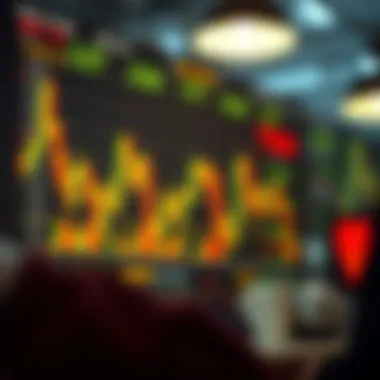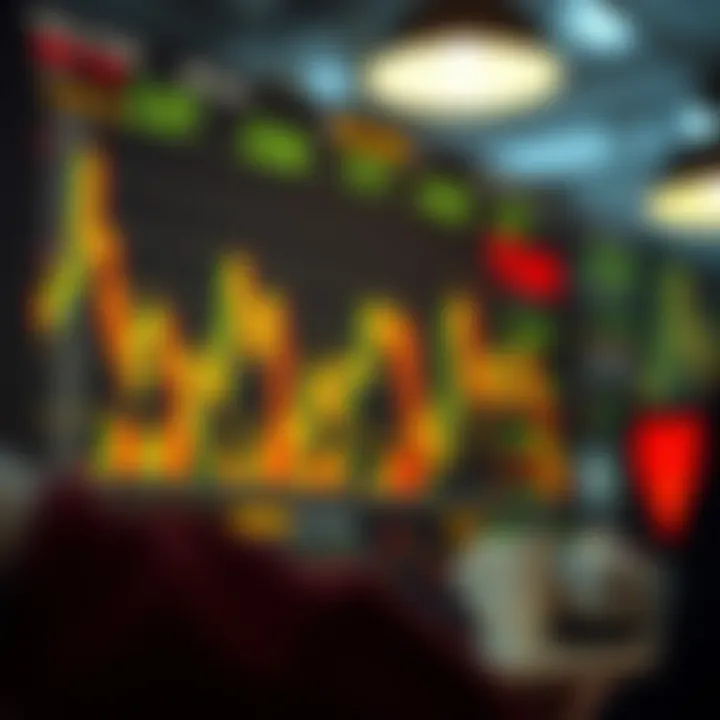In-Depth Guide to Japanese Candlestick Analysis


Intro
The realm of Japanese candlesticks is a fascinating area within technical analysis that draws both traders and analysts alike. Originating from Japan during the 18th century, these visual representations of price movement have stood the test of time, evolving into an essential tool in modern trading, especially in the cryptocurrency market. Each candlestick encapsulates critical information about price behavior over a specific period, showcasing not just the open, high, low, and close values, but also the psychological nuances of market participants.
Understanding candlestick patterns can serve as a compass for making more informed decisions in a highly volatile market. With that in mind, this article aims to demystify the intricacies of Japanese candlesticks, explaining their components, patterns, and the trading strategies that can be adopted. As the cryptocurrency market continues to burgeon, having a foundational grasp of candlestick analysis becomes a prerequisite for both novices and seasoned traders alike.
In a world driven by volatility, the ability to interpret candlestick information is not just useful; it’s imperative for those who wish to thrive as investors, analysts, and entrepreneurs. Let's embark on this journey to uncover the layers of meaning behind each candlestick and hone our skills in market analysis.
Foreword to Japanese Candlesticks
Japanese candlesticks have become a cornerstone in technical analysis, widely recognized for their ability to present complex market data in a clear and concise visual format. Understanding the intricacies of candlestick patterns is not just beneficial for traders; it's fundamental for anyone looking to navigate the often turbulent waters of financial markets, including cryptocurrency.
In essence, they serve as a lens through which traders and investors can gauge market sentiment, identify potential reversals, and anticipate price movements. By dissecting candlesticks, one can glean insights that may not be apparent from mere price charts, allowing for more informed decision-making.
Historical Background
The origin of Japanese candlesticks dates back to the 18th century in Japan, where a rice trader named homma Munehisa made significant advancements in market analysis. He discovered that the emotional reactions of traders could be predicted based on price movements. This historical perspective highlights the psychological underpinnings of pricing behaviors, as his techniques laid the groundwork for what we now know as candlestick charting. The key components—open, close, high, and low—were not just numbers; they were reflections of market mood and sentiment.
With the introduction of candlestick charting to Western markets in the late 20th century, this method quickly gained traction among investors keen on various financial instruments. Instead of relying solely on lines or bar charts, which lacked depth in emotional context, traders found candlesticks to be a more effective way to read the market.
The Emergence in Financial Markets
As global markets began to evolve in the 1990s, candlestick analysis emerged as a vital tool, particularly in the realm of stocks and futures. The shift to more advanced trading platforms allowed traders to integrate candlestick charts into their strategies, making it easier to visualize price changes over time. This transition also brought about a surge in educational resources, with books and seminars dedicated to understanding candlestick patterns.
The adaptability of candlestick analysis to various markets—stocks, forex, and now cryptocurrencies—marks its significance. In the crypto landscape, where volatility is rampant, these visual tools can aid in making quick, insightful trading decisions. Understanding the candlestick formations can help traders react to market changes dynamically instead of becoming overwhelmed by metrics alone.
Understanding candlestick patterns enhances your market acumen, allowing you to capitalize on price movements effectively.
Fundamental Components of Candlesticks
Understanding the fundamental components of Japanese candlesticks is critical to anyone looking to wield this tool effectively in financial markets. Each element of a candlestick holds valuable information, offering insights into market dynamics that can influence trading strategies. Being aware of these components enhances a trader's ability to interpret price movements, enabling informed decisions that can lead to successful outcomes. Moreover, grasping these basics is not just academic knowledge; it's akin to having the lay of the land before venturing into unknown territory.
Body, Wick, and Color
The body, wick, and color of a candlestick are its three main components, and each plays a pivotal role in conveying market sentiment. The body represents the area between the open and close prices for a specific time period. A longer body generally signifies stronger momentum, indicating that the buying or selling pressure was intense during that period.
The wicks, or shadows, extend from the body, showing the highest and lowest prices traded. These can provide context; a long upper wick suggests sellers stepped in strongly after a price advance, while a long lower wick indicates buyers resisted lower prices, which could signal potential reversals.
Color also carries meaning: a green or white candlestick typically indicates a bullish momentum, while a red or black candlestick indicates bearish sentiment. Therefore, recognizing patterns in the body, wick, and color can aid traders in predicting future price action. For example, if there are several consecutive bullish (green) candlesticks with small wicks, traders might feel confidence building up, suggesting a continuation of the trend.
Integration of Open, Close, High, and Low
To fully appreciate Japanese candlesticks, it is essential to understand how the four primary price components—open, close, high, and low—integrate into their overall painting.
Defining Each Component
The open price is where a candlestick begins, while the close is where it wraps up for that particular timeframe. The high and low indicate the extremes within that period. Here’s a quick breakdown:
- Open: The price at which a stock or asset begins trading for a period.
- Close: The concluding price at the end of the trading session.
- High: The maximum price achieved during that period.
- Low: The minimum price reached.
Understanding these definitions helps traders assess market conditions rapidly. For instance, if the opening price is significantly lower than the closing price, it often signals strong bullish sentiment. This structure is beneficial because it encapsulates vital information that traders can leverage to make decisions that align with market movements.
Understanding Interactions
The interplay of these four components is where the real insight emerges. The relationship between the open and close, as well as the high and low, gives traders a clearer picture of market sentiment and potential reversals. For instance, if a candlestick has a close that's notably higher than its open, it reflects buying strength and can signal upward momentum.
Conversely, if the close is near the low with a small body, it might indicate profit-taking or selling pressure. Understanding these interactions allows traders to gauge potential trends more accurately, making it easier to set effective entry and exit points.
In summary, the components and their interactions form a complete picture that goes beyond just the price action, allowing traders to navigate the markets with a better understanding of the underlying psychology driving those movements. This depth of insight from Japanese candlesticks can provide a distinct advantage in trading, particularly in the fast-paced world of cryptocurrency.
Candlestick Patterns


Candlestick patterns play an essential role in technical analysis, particularly for those involved in trading and investing. These patterns provide the tools necessary to interpret market movements and sentiment effectively. They are visual representations that not only reflect price action but also reveal the emotional state of the market participants. Understanding different patterns can significantly enhance a trader's ability to make informed decisions, which is crucial in the fast-paced environment of finance.
Single Candlestick Patterns
Single candlestick patterns are the foundational building blocks that traders analyze to gauge market dynamics. Each pattern offers distinct insights into traders' sentiments and helps to identify potential reversals or continuations in price movement. Here, we will cover three prominent single candlestick patterns: Doji, Hammer, and Shooting Star.
Doji
The Doji pattern is particularly notable because it represents indecision in the market. This candlestick forms when the opening and closing prices are nearly the same, resulting in a very thin body with long wicks. The key characteristic of a Doji is that it reflects uncertainty; market participants cannot establish a clear direction. This makes it a beneficial indicator for traders to watch for trend reversals or continuations.
One unique feature of the Doji is its ability to signal potential turning points, especially after a substantial price movement. For example, if a Doji appears after a bullish trend, it might suggest that the upward momentum is waning. The advantage of this pattern is that it requires little interpretation; its presence is self-explanatory in indicating indecision. However, it can also lead to false signals if not used in conjunction with other indicators.
Hammer
The Hammer pattern is recognized for its sturdy appearance, characterized by a small body at the upper end of the trading range and a long lower wick. This formation typically occurs after a downtrend and illustrates a potential reversal signal. The primary characteristic of a Hammer is its psychological implication; it indicates buyer resistance and potential support levels emerging in the market.
What sets the Hammer apart is its unique ability to illustrate the rejection of lower prices, suggesting the market's bullish potential. For traders, this pattern serves as a reliable entry point, especially when confirmed by rising volume in subsequent candles. While the Hammer can be beneficial as it often denotes strength in bullish momentum after a decline, it may also yield misleading results if traders jump in without considering market context.
Shooting Star
The Shooting Star pattern is in many ways the opposite of the Hammer. It appears at the top of an uptrend and is characterized by a small body at the bottom with a long upper wick. This design indicates that buyers tried to push the price higher, but sellers stepped in, creating downward pressure. The Shooting Star is a reflection of the sellers gaining control after a substantial move upward, making it a critical warning sign for investors.
A key characteristic of the Shooting Star is its potential to forecast a bearish reversal. Traders often prefer this pattern due to its clarity, especially when paired with volume spikes. The unique feature of this pattern is its indication of exhaustion among buyers. While it is a strong signal, it is equally important to approach it with skepticism, as false signals can occur, particularly in volatile markets.
Multiple Candlestick Patterns
Multiple candlestick patterns can provide an even richer context for interpreting market behavior. By examining a series of candles, traders can discern stronger signals than they might find through single candlestick analysis alone. In this section, we explore three significant multiple candlestick patterns: Engulfing Patterns, Harami, and Morning Star.
Engulfing Patterns
Engulfing Patterns arise when a small candlestick is followed by a larger one of the opposite color, representing a stronger shift in momentum. This pattern holds particular importance as it indicates a potential reversal point in the market. The key characteristic of Engulfing Patterns is the dominance of the second candle over the first. This makes them popular among traders seeking to capitalize on shifts in momentum and market sentiment.
One unique aspect of Engulfing Patterns is that they can appear in both bullish and bearish forms, providing versatility for traders. The advantages stem from their clear visual representation of buyer or seller strength, often leading to strategic entry points. However, the risk lies in relying solely on these candlesticks without considering the broader trend or additional confirming indicators.
Harami
The Harami pattern is intriguing and highlights a shift in market power. It consists of a large candlestick followed by a smaller one entirely contained within the body of the previous candle. This characteristic suggests indecision in the market and is often viewed as a signal for reversal. Harami is valuable for identifying potential turning points, especially when it appears after a sustained trend.
The Harami's unique feature lies in its subtlety, as it indicates a weakening trend rather than an outright reversal. Traders appreciate this pattern as a more conservative indicator, often using it to verify other signals before executing trades. While it offers clear insights into market behavior, reliance on context and additional market analysis is necessary to avoid premature decisions based on this candlestick alone.
Morning Star
The Morning Star pattern emerges as an essential three-candle formation. Consisting of a bearish candle, a small-bodied candle, and a bullish candle, it symbolizes a transition from bearish to bullish sentiment. The key characteristic of the Morning Star is the strong reversal potential it indicates. Seeing this pattern can prompt traders to enter positions with the expectation of future upward movement.
The unique advantage of the Morning Star is its complexity; it requires confirmation from subsequent pricing action to validate the reversal signal. This pattern is favored, especially in bullish markets, as it combines visual rigor with psychological insight into market shifts. However, traders should remain mindful of sudden price movements or market news that could disrupt the anticipated trend.
Psychology Behind Candlestick Movements
The intricate world of trading is not solely defined by numbers and charts; underlying it all is the psychology of market participants. Understanding the psychology behind candlestick movements is critical for any trader, as it helps decode market sentiments and trader behaviors. Essentially, the candlesticks act as a visual representation of collective trader emotions—fear, greed, and confidence. Capturing these emotions can be the difference between profitable trades and hefty losses.
By grasping the psychological aspects at play, investors can better anticipate market trends and make informed decisions, allowing them to navigate the unpredictable waters of financial markets with a more strategic mindset.
Market Sentiments and Trends
Market sentiment refers to the overall attitude of investors toward a particular security or financial market. At its core, market sentiment is influenced by various factors such as news, economic indicators, and even rumors. Candlestick charts offer distinct visual cues that reflect these sentiments through their patterns—rising or falling bodies, long or short wicks, and color variations provide indicators of market emotions.
Here are some aspects to consider concerning market sentiment:
- Bullish Sentiment: This generally indicates rising prices, often shown by green candlesticks and long bodies. Traders may observe higher volumes during such times, reinforcing the belief in upward price momentum.
- Bearish Sentiment: The opposite of bullish, displaying fear or hesitation among traders, often marked by long red candlesticks.
- Doji Patterns: A doji candlestick indicates indecision in the market, and its appearance can signal a potential reversal. This uncertainty may arise when investors are torn between rising and falling prices.
Recognizing these sentiments can allow traders to align their strategies more effectively with market movements, ultimately improving their chances of success.


Fear, Greed, and Decision-Making
Fear and greed are two primary emotions that drive market action. These sentiments can significantly skew rational decision-making, leading to impulsive trades that are not aligned with an investor’s long-term strategy. Understanding how these emotions impact market behavior is crucial for maintaining a disciplined trading approach.
- Fear of Missing Out (FOMO): Investors often experience FOMO during rapid price increases, which may lead to rushed investments based on emotion rather than solid analysis.
- Panic Selling: Conversely, when panic sets in due to negative news or market downturns, traders may sell off assets hastily, fearing further losses.
- Greedy Behavior: When the market is hot, the thrill of quick gains can cloud judgment, encouraging traders to hold on too long or enter trades without sufficient analysis.
By recognizing these emotional influences, traders can develop strategies to counteract their inherent biases, making them more likely to stick to well-researched plans rather than impulsive decisions.
"The market is a battlefield where emotions often lead to the downfall of even the most knowledgeable traders."
Understanding the psychology behind candlestick movements is more than just a useful tool for traders; it fosters a more comprehensive approach to market analysis. By recognizing how sentiment influences trends, and how emotions impact decision-making, investors can create a more robust trading strategy that considers the multifaceted nature of market movements.
For more insights about trading psychology and its effects on financial decisions, resources like Investopedia and Psychology Today can provide valuable perspectives.
Strategies for Trading With Candlestick Analysis
Trading using Japanese candlestick analysis can be a revealing endeavor. It's not just about reading prices on a chart; it's about understanding the story they tell. Here, we explore effective strategies that enhance trading decisions based on candlestick patterns. This section aims to delve into two primary strategies: identifying trends and combining candlesticks with other key indicators. These insights can help elevate trading acumen significantly.
Trend Identification
Identifying trends is foundational in trading. A trader must first ensure they are aligned with the overarching market direction. Not all candlestick formations indicate immediate price action. By discerning whether the market is in a bullish or bearish state, traders can make more informed decisions.
The simplest method is to observe consecutive bullish or bearish candlesticks. If you notice a string of green candles, that's a hint to hop on the upward trend. Conversely, a series of red candles may signal a downward trend. But that’s just scratching the surface. One might also want to examine the broader context, like support and resistance levels. A candlestick pattern developing near these critical levels could potentially foreshadow price reversals.
By being observant and patient, traders can leverage candlestick patterns to identify not just any trends, but the right trends to follow.
Combining with Other Indicators
To achieve a comprehensive trading approach, combining candlesticks with other indicators can bolster decision-making. Here are two widely respected tools: Moving Averages and the Relative Strength Index (RSI).
Moving Averages
Moving Averages act as smoothing tools, allowing traders to filter out the noise of erratic price fluctuations. By considering an average over a specific period, traders can identify whether prices are trending upward or downward. The distinct characteristic of Moving Averages lies in their ability to highlight the trend direction over time. This can potentiate other strategies, especially when aligning with candlestick formations. For instance, when a candlestick breaks above a moving average, it may suggest a strong bullish signal.
Benefits: The advantage here is clear: they provide traders a more reliable indication of where the market might go next, thus reinforcing the insight gained from candlestick patterns. However, note that they often lag behind the price, which could lead to missing earlier signals.
RSI
The Relative Strength Index (RSI) is a momentum oscillator that quantifies the speed and change of price movements. Traders often turn to RSI as it provides insights into whether a market is overbought or oversold. This is crucial in the context of candlesticks, as a candlestick pattern emerging when the RSI is in overbought territory often signals an impending price reversal.
Key Characteristics: The functionality of RSI allows traders to gauge market momentum, which can aid in confirming the signals congregated from candlestick patterns. The trick here is knowing how to interpret the RSI readings effectively. A reading above 70 typically indicates overbought conditions, while a reading below 30 suggests oversold ones. Still, relying only on RSI could be risky; thus, it works best when used alongside candlestick analysis.
Remember, while these tools can sharpen decision-making, they are never foolproof. The market is influenced by numerous factors. Always maintain a flexible approach that considers current events and broader market sentiment.
Conclusively, merging candlesticks with these indicators offers a strategic advantage. When utilized thoughtfully, these tools can illuminate patterns that might otherwise go unnoticed, aiding in more informed trading decisions.
Common Mistakes in Candlestick Trading
When venturing into candlestick trading, it’s all too easy to stumble into some pitfalls. Understanding these common errors can save traders from unnecessary losses and enhance their decision-making process. Recognizing the significance of potential missteps allows investors to navigate the intricate world of candlestick patterns with greater confidence.
Overlooking Context
One of the biggest blunders traders often make is overlooking the broader context in which candlestick patterns appear. Just like reading a novel, picking up just a random chapter won't give you the full story. Similarly, a single candlestick might suggest one thing, but its meaning can drastically change depending on the market environment or preceding trends.
For instance, consider a bullish engulfing pattern. On its own, this pattern indicates a potential price rise, but without examining previous market activity, such as existing downtrends or levels of support and resistance, traders might get caught off-guard. If the engulfing pattern emerges after an extended downtrend in a volatile market, this pattern could be a false signal, leading to misplaced trades. Therefore, always keep an eye out for:
- The preceding trend: Is the price rallying or slumping?
- Support and resistance levels: Are there barriers just above or beneath the formation of the pattern?
- Market news and events: What fundamental news could change the game's rules?
"Don't put all your eggs in one basket!" Be aware of how various elements play into your analysis.
Ignoring the context might lead to weary decisions based on patterns plucked out of thin air, rather than grounded in comprehensive market observation.


Misinterpreting Patterns
Misinterpretations of candlestick patterns are another common trap. Candlesticks are like a layered cake: the color, size, and shape all contribute to the flavor. However, each element carries weight and meaning. Misreading these factors can result in decisions that are completely off the mark.
Take the Doji candle, for example. It signifies indecision in the market, yet if a trader sees it and assumes it must immediately lead to a reversal, they might be barking up the wrong tree. Specifically, if a Doji forms after a vigorous price movement, it could simply indicate a pause rather than a complete turnaround.
To avoid misinterpretation, keep these factors in mind:
- Size of the body: A small body in a Doji usually points to indecision, but the context surrounding it is crucial.
- Wicks: Long wicks can indicate rejection of price levels; thus, they often carry more insight than the body itself.
- Confirmation required: Never jump the gun; look for additional candles that confirm the initial signal.
Engaging in a detailed analysis of candlestick formations fosters better understanding and minimizes errors.
In summary, avoiding mistakes requires patience, a watchful eye on context, and meticulous interpretation of patterns. By paying attention to these factors, traders can position themselves more favorably in the complex realm of candlestick trading.
Case Studies of Successful Candlestick Trading
The realm of candlestick trading isn't just a theoretical landscape; it thrives on practical applications and real-world success stories. Understanding these case studies can illuminate the nuances of market behavior and the effectiveness of candlestick analysis. It helps traders draw connections between patterns and outcomes, enhancing their overall trading strategy.
Analyzing Historical Data
When we look back at historical trading data, we find a rich tapestry woven with patterns and behaviors that echo through time. Analyzing such data allows traders to reconstruct past market scenarios where particular candlestick patterns played a pivotal role. For instance, consider the Morning Star pattern that typically signals a bullish reversal following a downtrend. A study of historical instances where this pattern formed can unravel not just the price moves that followed but also the trader sentiment and volume trends at that moment.
Moreover, historical data sheds light on the context of the patterns. In particular, it reveals how external factors—such as economic indicators or geopolitical events—may have influenced market reactions. Traders can create a more profound understanding by observing not just what happened, but why it happened, invoking a sense of insight that extends beyond simple pattern recognition.
To derive actionable strategies, traders can tabulate historical data of the patterns they wish to analyze. This could be laid out as:
- Date and Time: When the pattern occurred
- Pattern Type: Name of the candlestick pattern
- Price Movement: Subsequent high or low prices observed
- Volume Trends: Was it accompanied by high trading volume?
- External Factors: Any news or reports during that time
By keeping these factors in mind, traders can enter the market equipped with historical context, increasing their confidence and providing a clearer lens through which to interpret future candles.
Real-World Application in Cryptocurrency
In the fast-paced world of cryptocurrency, the application of candlestick analysis stands as a guiding star on the horizon. While traditional markets might offer some structure, the crypto scene thrives on volatility, where candlestick patterns can often signal pivotal movements.
Take the Engulfing pattern, for example. One notable instance occurred in late 2020 when Bitcoin caught media attention, resulting in significant price surges. Analyzing the candlesticks of that period reveals a series of bullish engulfing patterns right before notable price breaks. Investors who recognized these signals positioned themselves effectively, hence witnessing substantial profits.
However, the crypto landscape is not only about individual coins. Platforms like Binance, known for their high trading volume, offer traders insights into market movements through candlesticks. Many algorithms and trading bots that utilize these patterns operate on such platforms, often reinforcing trends highlighted by human traders.
Another compelling case can be found within Ethereum’s price movements prior to major updates or forks. Candlestick patterns during transitional phases often reflect underlying investor sentiment—whether they anticipate growth or are fearful of dilution.
The takeaway from these observations is invaluable. Successful traders do not simply react to patterns; they analyze their implications in the context of broader market conditions. Here, understanding how various crypto assets react differently to similar candlestick formations is crucial. Each coin’s underlying technology, community sentiment, and upcoming events can influence how accurately these patterns predict future performance.
In summary, analyzing historical data alongside real-world applications in cryptocurrencies can provide depth to candlestick trading. By learning from past successes and failures, traders can sharpen their approach, arming themselves with not just knowledge, but wisdom that evolves in tandem with the market.
Finale and Future Perspectives
As we approach the end of this exploration into Japanese candlesticks, it’s essential to reflect on the significant insights gained. The art and science behind candlestick analysis provide traders and investors with a visual means to interpret market behavior, illustrating price dynamics and trader psychology. This section encapsulates the crux of our discussion and offers a forward-looking view on how these tools might evolve.
Summation of Key Insights
Japanese candlesticks serve as more than just a graphical representation of price movements; they are a window into the emotional state of the market participants. The patterns, whether single or multiple candlesticks, unveil not just past price action but invite a consideration of market sentiment. Here are several core takeaways:
- Historical Relevance: The roots of candlestick analysis date back centuries, influencing modern trading practices. Understanding its inception can enhance one’s appreciation and application today.
- Components Matter: The body and wicks of the candlestick work together to narrate a story of market behavior, revealing potential reversals or continuations based on their structure and color.
- Behavioral Insights: Awareness of fear, greed, and decision-making processes as they pertain to candlestick formations helps traders refine their strategies. Recognizing emotional trends can lead to more informed trading actions.
- Application Across Markets: While our focus largely centered on cryptocurrency, the principles of candlestick analysis apply across various financial markets, providing a versatile tool for traders.
In other words, when one gains mastery over these components, the path to improving trading strategies grows clearer. Traders can enhance their decision-making processes, leading to potentially improved outcomes in their investments.
The Future of Candlestick Analysis in Crypto Markets
Looking ahead, the future of candlestick analysis, particularly within the realm of cryptocurrency, seems both promising and filled with transformation. As the cryptocurrency landscape continues to mature and evolve, several factors will influence how traders utilize candlestick charts:
- Increased Data Accessibility: With the proliferation of trading platforms and analytical tools, more traders can access historical data. This accessibility allows for enhanced back-testing of candlestick strategies.
- Integration of Advanced Technologies: Artificial intelligence and machine learning could start analyzing candlestick patterns more efficiently. This shift might lead to more precise trading algorithms that can operate in real-time, reacting to market fluctuations faster than human traders.
- Regulatory Developments: As governments tighten their grip on cryptocurrency regulations, market behavior will inevitably shift. Understanding how these changes affect trader psychology will become critical for interpreting candlestick patterns.
- Adaptive Strategies: The volatile nature of cryptocurrencies suggests that candlestick patterns might require ongoing adaptation. Traders need to remain agile, adapting strategies to the rapid changes in market dynamics.
For further reading on candlestick trading strategies, consider these resources:
- Investopedia - Candlestick Patterns
- Investing.com - Candlestick Charting
- CoinMarketCap - Cryptocurrency Market Analysis
Understanding candlesticks is like learning a new language. It takes time, but once grasped, it can open new avenues in trading, leading to more informed decisions and greater financial success.



